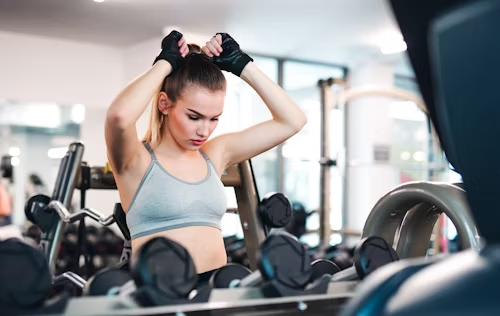When picking a support garment between sports bras and conventional bras, one faces a choice between comfort and structural support. The two types of underwear fulfil important functions that distinguish them by how they support bodies and match unique body types and fashion requirements. A knowledge of the specific strengths of bras and sports bras will direct your clothing choices regardless of whether you wear athletic gear for fitness or standard clothing for work or leisure.
This guide shows you the different functions and fits of sports bras vs. traditional bras as they apply to your body shape, daily needs, and dress code requirements.
What Is a Sports Bra?
Sports bras function to bring optimal support to active women while participating in sports activities. These bras serve three important purposes during workouts: minimising breast movement, reducing chest strain, and enhancing overall comfort. The typical sports bra consists of stretchable, breathable polyester and spandex material with wide straps and full-coverage construction and a strong elastic band design like Venaixtr Athletica.
Sports bras offer three common levels of support:
Athletic activities requiring low-impact support, such as yoga, stretching, and walking
Sports activities requiring medium-impact support, such as cycling and dancing
Sports activities requiring high-impact support, such as running, jumping, and HIIT
Sports bras appear in two main styles: compression, which pushes the breasts against the chest wall and encapsulation, which maintains individual breast support. Most current designs unite both compression and encapsulation functions to deliver maximum performance benefits.
What Is a Traditional Bra?
A daily-use traditional bra features multiple styles such as push-up, plunge, balconette, and strapless, along with many other options. These bras help define and lift the bust through their structural construction. Most have adjustable straps and hook-and-eye closures, moulded cups, and optionally underwires.
Traditional bras differ from sports bras because they pick which body effects they create to work best under specific apparel. Optimal bra selection boosts your form and posture and builds self-esteem when worn with formal or casual or formal attire.
Function: Support with Purpose
Bras perform different functions based on specific requirements:
The active-focused Sports Bra delivers support and controls bounce while maintaining comfort through breathability. These features keep you comfortable during physical activities while protecting your tissues from potential damage over time. Additionally sports bras feature moisture-wicking materials which control excessive sweating.
The Traditional Bra presents an arrangement that gives users both visual enhancement and body architectural support. These traditional bras support your upper body by shaping your chest line while giving you an elevated bust and better body alignment beneath garments. These bras suit situations when style and body structure need to stay ahead of physical movement requirements.
Casual wear with sports bras gives minimal bust shaping and lift quality underneath fitted professional clothes.
Fit: What Feels Right?
Both bra types achieve best results through optimal fit. Proper fit remains essential in both kinds of support garments (sports and traditional). Bra sizing errors lead to discomfort and pain and may trigger health issues related to posture and shoulder strain.
The perfect sports bra needs to fit tight without tightening excessively. It reduces breast movement without compromising your breathing ability. Many sports bras achieve seamless construction and padded straps to improve user comfort during exercise. If the sports bra balances firm support with softness then you can use it for both workouts and daily wear.
Traditional Bras enable proper bust support while maintaining affordable strap and rib comfort. Adjustable bras support natural body contours and form a flat base against your sternum. Proper band and cup sizing both count toward a perfect fit—schedule professional measurement once each year.
The support system of both bra types accomplishes three things: they create even support and eliminate strap discomfort and band discomfort and prevent cup discomfort.
Fashion: Style Meets Function
Undergarment designs have combined aesthetics with functional elements over recent years. Modern sports bras provide athletic users with attractive fabrics and cuts that let them dress for both casual and sports and athletic-wear in addition to their gym workouts.
Many women combine sports bras as activewear with either tank tops or roomy shirts during daily activity or wear the bra itself as a single top. Designers use mesh trims and zipper additions and printed designs and cut-out patterns to take activewear to fashion heights.
Traditional Bra Fashion: These bras offer the most variety in terms of fashion. Baker’s Market offers date night-ready lingerie that combines delicate lace embroidered details with trending jumpers and classic satin finishes to elegant everyday date night wear. They produce styles that fit any fashion need by delivering sexy lingerie alongside invisible t-shirt bras.
Sports bra functional designs inject performance capability into your closet, while traditional bras supply stylish shaping solutions for your support needs, like a blue sports bra.
Final Thoughts: Which One Is Right for You?
Sports bras and traditional bras establish two essential components in a well-rounded wardrobe. The needs you have determine which one suits you best, so you don’t need to pick only one. Sports bras provide superior body support and comfort during physical activities while traditional bras enhance your appearance with added lift and shape beneath elegant garments.
Your choice of bra should consider how your day unfolds and how you desire to feel in addition to how your clothes fit. Some situations call for loose freedom while others require defined structure. You’ll stay ready for every social circumstance when you have access to both choices because fitness and meetings, and downtime all require different styles.

